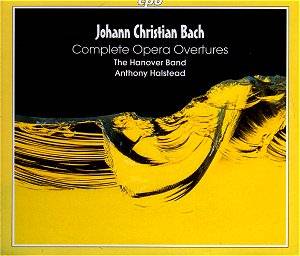It
is conventional criticism to commence a review of such a boxed
set by saying that these pieces are individually enjoyable but
you would not want to listen to them all at once. Well, wrong
Ö I would, and did. These are completely engrossing works and
Anthony Halsteadís marvellous players have caused me to spend
several hours exploring this and related repertoire.
The
brief biographical note duplicated in each of the three booklets
(these CDs were previously available separately and were recorded
over several years) tell a rather sad tale of yet another famous
and successful composer destined to die young, in debt, and unmourned
by a hard-hearted public. That he was a close friend of none other
than Mozart for twenty years of his short life draws the parallel
still closer. It is too easy to see the post J.S.Bach period as
one consisting of a gap followed by Haydn and Mozart. In fact
the sons of Bach included several very fine musicians indeed;
Johann Christian is one, with the other most significant being
Carl Philipp Emanuel. These two have only to be heard to alert
the listener to their importance. Sons of Bach they may have been,
but clones they were not. Johann Christian is urbane, skilled
and blessed with an almost Mozartian grace. Carl Philipp Emanuel
is emotional and (within context) wild to the point of eccentricity
("full of forbidden dissonances", "all very disturbing",
says one contemporary review). Since both were prolific composers,
the journey through the present set and subsequently through everything
else I could find in my collection provided many a pleasurable
hour. Had I decided to carry on with the non-Bachs too I might
never have got round to writing this review.
If all that leads the reader to believe I liked this big set of
Overtures then he or she is correct. In contrast to the brief
biography mentioned above, the notes by Ernest Warburton (CD1
and 2) and Andreas Friesenhagen (CD3) on each opera overture are
extensive and very informative. Apart from summarising plots they
also talk of the performance history of these mostly very successful
operas. The notes also detail why some of the overtures turned
into symphonies with or without changes. Recycling was in full
swing throughout the Baroque and Classical periods. It is almost
comical to imagine what the modern school of originality-or-bust
would have made of such wholesale reuse of material (not always
by its original owner!).
The Hanover Band are working through Johann Christianís entire
orchestral output for CPO. A visit to http://www.cpo.de
will confirm the huge number of CDs that has resulted. By contrast
Carl Philipp Emanuel is less well served but I note the enterprising
BIS is starting work on a similar "authentic instruments"
exploration with the Bach Collegium of Japan though that has yet
to reach the "disturbing" symphonies. Each of J.C.ís
Overtures is a three movement Sinfonia in the Italian Style,
generally simply Allegro, Andante, Allegro. The overture
functioned as a prelude to the eveningís entertainment and not
as a preview of the main tunes of the opera, as it was to become
later, so taking them out of context is completely viable. On
the surface one might expect both the remarkable Hanover Band
and your unremarkable reviewer to get bored with so much fast-slow-fast
early classical stuff. But as is the case with Vivaldi and Corelli
from an earlier time, these do not pall. If I were to pick out
something to tickle the listenerís fancy it would be the very
last track in the box, CD3 Track 24, the Tambourin from
the Ballet Music to Amadis des Gaules, a total charmer
of a piece. One listen and you are lost. Mention must be made
finally of the excellent and mysterious chorus and vocal soloists
in this Ballet. I say mysterious because they rate no mention
anywhere. It might be the musicians in the Hanover band singing
along, but I doubt it. We should be told.
Dave
Billinge
